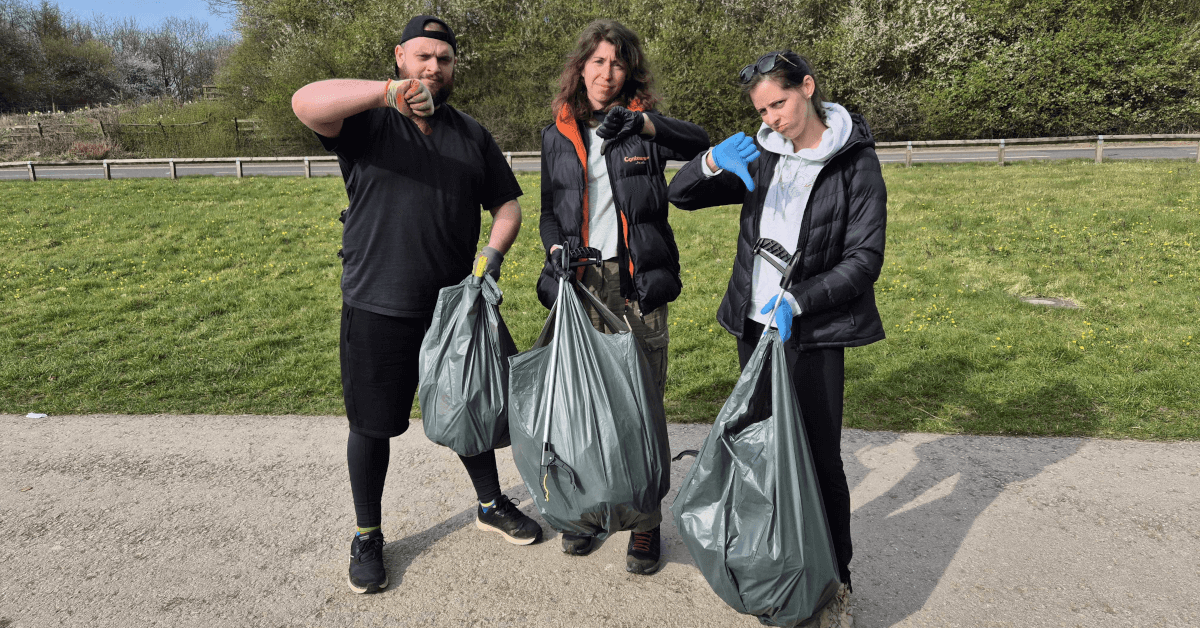Things Found
Contours reflect on the impact of human life on natural spaces, prompted by the things found on our litter-picking walk around Carsington Water.
Things Found
https://contoursrun.co.uk/things-found
by Monika Gesson
A yellow metal tape measure, fully unfurled. A grey plastic hubcap from a Ford. A surprisingly intact 2013 Panini Adrenalyn #67 card featuring Ryan Giggs at Manchester United. These were some of the things retrieved from the undergrowth in the wooded areas bordering Carsington Water, and which made up the contents of the heavy bin liners each of us toted along the top of the dam wall.
I was on the final stretch of my first outing with the team at Contours Holidays: a litter-picking expedition along the Carsington Water Dam Trail, a gentle circular walk just under three miles long. In honour of Global Recycling Day on March 18th and World Earth Day on April 22nd, four members of the Contours Holidays team (and two representatives from our fuzzball department) set out on the morning of Friday, April 4th to do our bit to support our local environment.
We at Contours Holidays are privileged to have our HQ sited in the administrative centre of the Derbyshire Dales, a region known for its striking landscapes and dramatic geological features, and also recognised as a haven for biodiversity.

The views from where we walked atop the dam wall at Carsington Water are no exception to that account, so that even as a fresh wind swept into us from across the reservoir, buffeting us and our unsavoury cargo, it was difficult not to feel a sense of accomplishment in our task — an example of human action upon nature for the benefit of both parties.
Despite its undeniable tranquillity, the countryside around Carsington Water shows no shortage of human action upon nature.
Carsington Water itself is a man-made reservoir; the dam wall we walked across was moulded from the earth not once, but twice, following a partial collapse just over 40 years ago. Above the water, sleek and graceful turbines sprout like giant spring bulbs from the pastures that make up Carsington Wind Farm. Beyond them, dusty quarries bear the gouges and scrapes of stone hewn over hundreds of years.
These signs of industry and development speak of our mastery over a landscape that has so far yielded to us. What we found on our three-hour walk suggests it is time we as a society turned our hands from taking and making, to giving back.
We arrived at Carsington Water with four large bin liners, two litter picker sticks (with pistol grips that lent a sense of precision and authority), and some borrowed garden gloves. At that point, not one of us expected to find a great deal of litter along our way. It was excellent just to be out on the trail.
It wasn’t long before our eyes adjusted and, here and there, the objects of our mission drew into focus. Pieces of bumper bar, wing mirror casings. Soda cans, cigarette butts and booze bottles. Disposable coffee cups and plastic bags in all stages of decomposition. Dog poop bags. So many, many dog poop bags. All went into our sacks as we picked and poked in the paddocks under the wary gaze of nearby sheep.

By the time we’d wound our way through the pretty grasslands and quiet woodlands of the lower path, crossed the Scrow Brook and started our climb up the embankment, the bin liners we’d never thought we’d fill were overflowing. We tied them shut and carried them back to the Visitor Centre where we began our walk.
It is worth knowing that while Carsington Water is a beautiful countryside locale, it isn’t a remote wilderness miles off the beaten track. It is a tourist spot, visited and loved by around a million visitors a year and a major centre for outdoor activities like walking, fishing, sailing and windsurfing. The area in which it lies has long been inhabited. In fact, in the middle of the reservoir, lying submerged under 36,331 megalitres of very cold water, are the remains of a Roman villa.
The building of the dam in the 1960s prompted archaeological surveys which revealed a number of interesting artefacts, including lead pigs, pieces of broken tile and spindle whorls. From these bits and bobs, experts have been able to piece together an idea of what life might have looked like for the people who lived at Carsington in Roman times. They were engaged in mining and smelting activities. They span fibres into yarns, ropes and fabrics. They designed and built homes with shiny pink roofs made of mica sandstone that would have gleamed under the sun. We know all this from what those long-gone people left behind.
If experts almost two thousand years from now were to assess us from what we leave behind today, what would they think our society was like? As we live in the present day, the answer to that question won’t come from the ‘Time Team’, but rather from the ‘Grime Team’ — those setting out for a walk with a bin bag in tow, making it their mission to leave only our society’s best efforts in the landscape to be found.
Our very own Grime Team returned to the office on Friday afternoon, a little spent but satisfied, having left nothing behind except footprints.
